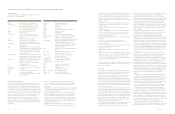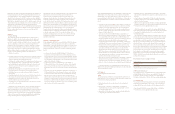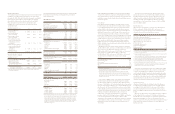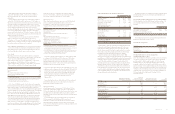OG&E 2014 Annual Report Download - page 15
Download and view the complete annual report
Please find page 15 of the 2014 OG&E annual report below. You can navigate through the pages in the report by either clicking on the pages listed below, or by using the keyword search tool below to find specific information within the annual report.26 OGE Energy Corp. OGE Energy Corp. 27
amounts allowable for recovery or refund in future rates. The benefit
obligations regulatory asset is comprised of expenses recorded which
are probable of future recovery and that have not yet been recognized
as components of net periodic benefit cost, including net loss and prior
service cost.
Unbilled Revenues
OG&E reads its customers’ meters and sends bills to its customers
throughout each month. As a result, there is a significant amount of
customers’ electricity consumption that has not been billed at the end
of each month. Unbilled revenue is presented in Accrued Unbilled
Revenues on the Consolidated Balance Sheets and in Operating
Revenues on the Consolidated Statements of Income based on
estimates of usage and prices during the period. At December 31,
2014, if the estimated usage or price used in the unbilled revenue
calculation were to increase or decrease by one percent, this would
cause a change in the unbilled revenues recognized of $0.3 million.
At December 31, 2014 and 2013, Accrued Unbilled Revenues were
$55.5 million and $58.7 million, respectively. The estimates that
management uses in this calculation could vary from the actual
amounts to be paid by customers.
Allowance for Uncollectible Accounts Receivable
Customer balances are generally written off if not collected within
six months after the final billing date. The allowance for uncollectible
accounts receivable for OG&E is calculated by multiplying the last
six months of electric revenue by the provision rate. The provision rate
is based on a 12-month historical average of actual balances written
off. To the extent the historical collection rates are not representative
of future collections, there could be an effect on the amount of
uncollectible expense recognized. Also, a portion of the uncollectible
provision related to fuel within the Oklahoma jurisdiction is being
recovered through the fuel adjustment clause. At December 31, 2014,
if the provision rate were to increase or decrease by 10 percent, this
would cause a change in the uncollectible expense recognized of
$0.1 million. The allowance for uncollectible accounts receivable is a
reduction to Accounts Receivable on the Consolidated Balance Sheets
and is included in Other Operation and Maintenance Expense on the
Consolidated Statements of Income. The allowance for uncollectible
accounts receivable was $1.6 million and $1.9 million at December 31,
2014 and 2013, respectively.
Accounting Pronouncements
See Note 2 of Notes to Consolidated Financial Statements for
discussion of a current accounting pronouncement that is applicable
to the Company.
Commitments and Contingencies
In the normal course of business, the Company is confronted with
issues or events that may result in a contingent liability. These
generally relate to lawsuits or claims made by third parties, including
governmental agencies. When appropriate, management consults with
legal counsel and other appropriate experts to assess the claim. If, in
management’s opinion, the Company has incurred a probable loss as
set forth by GAAP, an estimate is made of the loss and the appropriate
accounting entries are reflected in the Company’s Consolidated
Financial Statements. At the present time, based on currently available
information, the Company believes that any reasonably possible losses
in excess of accrued amounts arising out of pending or threatened
lawsuits or claims would not be quantitatively material to its financial
statements and would not have a material adverse effect on the
Company’s consolidated financial position, results of operations or
cash flows. See Notes 14 and 15 of Notes to Consolidated Financial
Statements in this Annual Report for a discussion of the Company’s
commitments and contingencies.
Environmental Laws and Regulations
The activities of the Company are subject to numerous, stringent and
complex Federal, state and local laws and regulations governing
environmental protection. These laws and regulations can change,
restrict or otherwise impact OG&E’s business activities in many ways
including the handling or disposal of waste material, future construction
activities to avoid or mitigate harm to threatened or endangered
species and requiring the installation and operation of emissions
pollution control equipment. Failure to comply with these laws and
regulations could result in the assessment of administrative, civil and
criminal penalties, the imposition of remedial requirements and the
issuance of orders enjoining future operations. OG&E believes that its
operations are in substantial compliance with current Federal, state
and local environmental standards.
Environmental regulation can increase the cost of planning, design,
initial installation and operation of OG&E’s facilities. Historically,
OG&E’s total expenditures for environmental control facilities and for
remediation have not been significant in relation to its consolidated
financial position or results of operations. The Company believes,
however, that it is reasonably likely that the trend in environmental
legislation and regulations will continue towards more restrictive
standards. Compliance with these standards is expected to increase
the cost of conducting business. Management continues to evaluate
its compliance with existing and proposed environmental legislation
and regulations and implement appropriate environmental programs
in a competitive market.
OG&E expects that environmental expenditures necessary to comply
with the environmental laws and regulations discussed below will
qualify as part of a pre-approval plan to handle state and Federally
mandated environmental upgrades which will be recoverable in
Oklahoma from OG&E’s retail customers under House Bill 1910,
which was enacted into law in May 2005.
It is estimated that OG&E’s total expenditures to comply with
environmental laws, regulations and requirements for 2015 will be
approximately $136.0 million, of which $116.0 million is for capital
expenditures. It is estimated that OG&E’s total expenditures to comply
with environmental laws, regulations and requirements for 2016 will be
approximately $159.0 million, of which $139.0 million is for capital
expenditures. The amounts for OG&E above include capital
expenditures for low NOX burners, activated carbon injection
and scrubbers.
Air
Federal Clean Air Act Overview
OG&E’s operations are subject to the Federal Clean Air Act as
amended, and comparable state laws and regulations. These laws and
regulations regulate emissions of air pollutants from various industrial
sources, including electric generating units, and also impose various
monitoring and reporting requirements. Such laws and regulations
may require that OG&E obtain pre-approval for the construction or
modification of certain projects or facilities expected to produce air
emissions or result in the increase of existing air emissions, obtain
and strictly comply with air permits containing various emissions and
operational limitations or install emission control equipment. OG&E
likely will be required to incur certain capital expenditures in the future
for air pollution control equipment and technology in connection with
obtaining and maintaining operating permits and approvals for
air emissions.
Regional Haze Control Measures
The EPA’s 2005 regional haze rule is intended to protect visibility in
certain national parks and wilderness areas throughout the United
States that may be impacted by air pollutant emissions.
On February 18, 2010, Oklahoma submitted its SIP to the EPA,
which set forth the state’s plan for compliance with the Federal regional
haze rule. The SIP was subject to the EPA’s review and approval.
The Oklahoma SIP included requirements for reducing emissions of
NOX and SO2 from OG&E’s seven BART-eligible units at the Seminole,
Muskogee and Sooner generating stations. The SIP also included a
waiver from BART requirements for all eligible units at the Horseshoe
Lake generating station based on air modeling that showed no
significant impact on visibility in nearby national parks and wilderness
areas. The SIP concluded that BART for reducing NOX emissions at
all of the subject units should be the installation of low NOX burners
with overfired air (flue gas recirculation was also required on two of
the units) and set forth associated NOX emission rates and limits.
On December 28, 2011, the EPA issued a final rule in which it
rejected the SO2 portion of the Oklahoma SIP and issued a FIP in its
place. OG&E and the State of Oklahoma’s subsequent appeal of the
FIP with the Tenth Circuit of Appeals and the U.S. Supreme Court
ended on May 27, 2014 when the Supreme Court denied OG&E’s
Petition for Certiorari, upholding the EPA’s FIP for SO2. The FIP
compliance date is now January 4, 2019.
On August 6, 2014, OG&E filed an application with the OCC for
approval of its plan to comply with EPA’s MATS and Regional Haze FIP
while serving the best long-term interests of customers in light of future
environmental uncertainties. The application seeks approval of the
environmental compliance plan and for a recovery mechanism for
the associated costs. The environmental compliance plan includes
installing dry scrubbers at Sooner Units 1 and 2 and the conversion
of Muskogee Units 4 and 5 to natural gas. The application also asks
the Commission to predetermine the prudence of replacing OG&E’s
soon-to-be retired Mustang steam turbines in late 2017 (approximately
460 MW) with 400 MW of new, efficient combustion turbines at the
Mustang site in 2018 and 2019 and approval for a recovery mechanism
for the associated costs. OG&E estimates the total capital cost
associated with its environmental compliance plan included in this
application to be approximately $1.1 billion. The OCC hearing on
OG&E’s application is scheduled to commence on March 3, 2015.
Multiple parties advocating a variety of positions have intervened in
the proceeding. OG&E expects a ruling from the OCC in the second
quarter of 2015. At this time, OG&E cannot predict the outcome of the
proceeding. OG&E plans to file applications in the first quarter of 2015
seeking related approvals from the APSC.
Cross-State Air Pollution Rule
In August 2011, the EPA published its Cross-State Air Pollution Rule
that would require 27 states to reduce power plant emissions that
contribute to ozone and particulate matter pollution in other states. In
December 2011, the EPA published a supplemental Cross-State Air
Pollution Rule, which would make six additional states, including
Oklahoma, subject to the Cross-State Air Pollution Rule for NOX
emissions during the ozone-season from May 1 through September 30.
Under the rule, OG&E would have been required to reduce ozone-
season NOX emissions from its electrical generating units within the
state beginning in 2012. In response to legal challenges of the final
rule on December 30, 2011, the U.S. Court of Appeals issued a stay
of the rule, which includes the supplemental rule, pending a decision
on the merits. By order dated August 21, 2012, the Court of Appeals
vacated the Cross-State Air Pollution Rule and ordered the EPA to
promulgate a replacement rule. On April 29, 2014, the U.S. Supreme
Court reversed the decision by the Court of Appeals. On October 23,
2014, the Court of Appeals for the District of Columbia Circuit granted
the EPA’s request that the court lift the stay of the Cross-State Air
Pollution Rules. The EPA subsequently clarified that compliance with
the Cross-State Air Pollution Rule would begin in 2015 using the
amount of allowances originally scheduled to be available in 2012.
OG&E already has installed low NOx burners on many of its generating
units, and OG&E is continuing to evaluate what additional measures,
if any, will be needed for compliance with the rule. In the meantime,
the petitions for review of the Cross-State Air Pollution Rule and the
supplemental rule remain pending before the DC Circuit Court of
Appeals for consideration of issues not addressed by the Supreme
Court’s decision.
Hazardous Air Pollutants Emission Standards
On April 16, 2012, regulations governing emissions of certain
hazardous air pollutants from electric generating units were published
as the final MATS rule. To comply with this rule, OG&E is currently
planning to utilize activated carbon injection for the removal of mercury
at each of its five coal-fired units, the capital costs of which are
estimated to be approximately $20 million over a three year period
and are included in the capital expenditures table in “Future Capital
Requirements and Financing Activities” above. The final MATS rule has
been appealed by several parties and is now before the US Supreme
Court. OG&E is not a party to the appeals and cannot predict the
outcome of any such appeals.
Federal Clean Air Act New Source Review Litigation
As previously reported, in July 2008, OG&E received a request for
information from the EPA regarding Federal Clean Air Act compliance
at OG&E’s Muskogee and Sooner generating plants.
On July 8, 2013, the Department of Justice filed a complaint against
OG&E in United States District Court for the Western District of
Oklahoma alleging that OG&E did not follow the Federal Clean Air Act
procedures for projecting emission increases attributable to eight
projects that occurred between 2003 and 2006. This complaint seeks
to have OG&E submit a new assessment of whether the projects were
likely to result in a significant emissions increase. The Sierra Club
intervened in this proceeding. On August 30, 2013, the Government
filed a Motion for Summary Judgment and on September 6, 2013,
OG&E filed a Motion to Dismiss the case. On January 15, 2015, U.S.
District Judge Timothy DeGuisti dismissed the complaints filed by EPA
and Sierra Club. The Court held that it lacked subject matter jurisdiction
over Plaintiffs’ claims because Plaintiffs failed to present an actual
“case or controversy” as required by Article III of the Constitution. The
court also ruled in the alternative that, even if Plaintiffs had presented
a case or controversy, it would have nonetheless “decline[d] to exercise
jurisdiction.” EPA and the Sierra Club have until March 16, 2015 to file
an appeal of the Court’s ruling.
























